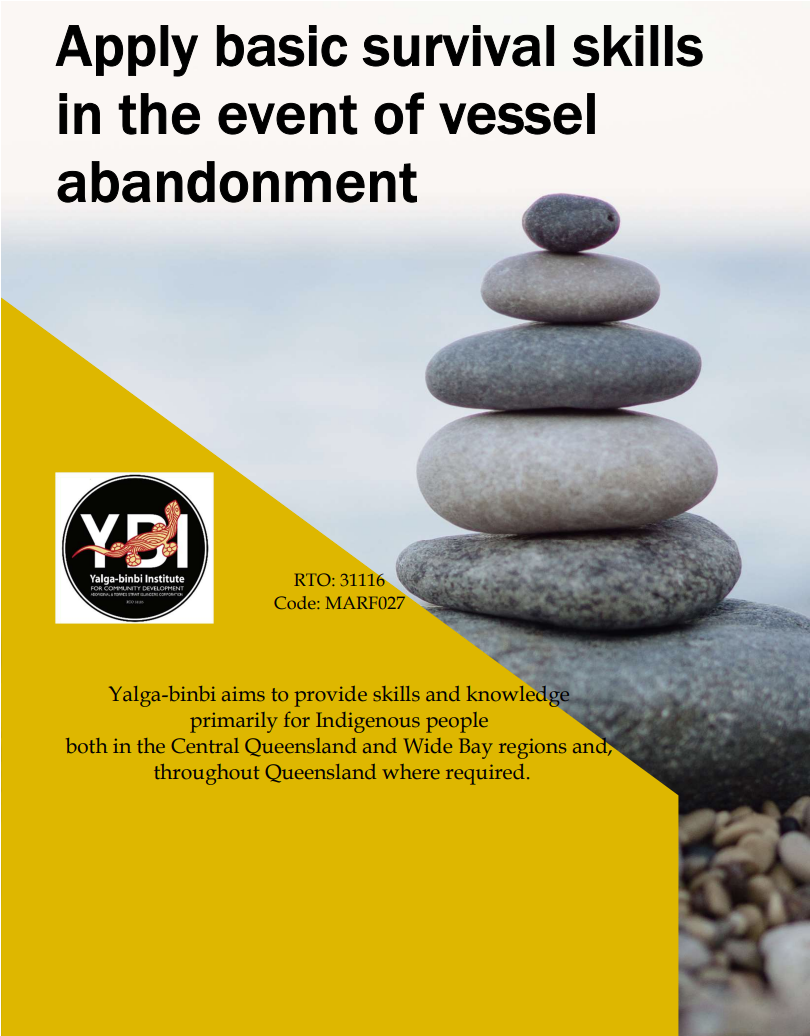SPECIAL MARITIME TRAINING CALENDAR
Apply basic survival skills in the event of vessel abandonment
Qualification Code MARF027
AU$650.00
MARF027 - Apply basic survival skills in the event of vessel abandonment (Release 1)
Save this product for later
Apply basic survival skills in the event of vessel abandonment
Product Details
Modification History
|
Release 1. New unit of competency. Licensing/regulatory information has been incorporated in accordance with Regulatory requirements. Assessment Requirements have been strengthened in accordance with Regulatory requirements. |
Application
|
This unit involves the skills and knowledge required to apply basic survival skills in the event of vessel abandonment. This unit applies to people working in the maritime industry in a deck and or engine room capacity on vessels up to 80 m and with propulsion power <3000 kW within the exclusive economic zone (EEZ). They could be working independently or as part of a vessel crew. Licensing/Regulatory Information Legislative and regulatory requirements are applicable to this unit. This unit is one of the requirements to obtain Australian Maritime Safety Authority (AMSA) certification as a General Purpose Hand NC, Coxswain Grade 2 NC, Coxswain Grade 1 NC, Marine Engine Driver Grade 3 NC, Master (Inland waters), Master <24 m NC, Marine Engine Driver Grade 2 NC, Mate <80m NC, Master < 35 m NC and Marine Engine Driver Grade 1 NC, as defined in the National Standard for Commercial Vessels (NSCV) Part D. The AMSA mandated practical assessment (AMPA) is a requirement for AMSA certification. The Australian Maritime Safety Authority (AMSA) mandated practical assessment (AMPA) will cover a range, but not all, of the requirements identified in the Performance Evidence and Knowledge Evidence. The AMPA shall be undertaken in accordance with its instructions. Assessors of AMPA must hold as a minimum:
|
Pre-requisite Unit
|
Not Applicable |
Competency Field
|
F – Operational Quality and Safety |
Unit Sector
|
Not Applicable |
Elements and Performance Criteria
|
ELEMENTS |
PERFORMANCE CRITERIA |
||
|
Elements describe the essential outcomes. |
Performance criteria describe the performance needed to demonstrate achievement of the element. |
||
|
1 |
Prepare to abandon vessel |
1.1 |
Nature of emergency is determined to minimise potential dangers and threats |
|
1.2 |
Muster and abandon vessel signals are responded to according to vessel safety procedures |
||
|
1.3 |
Survival equipment is organised to maximise chances of survival |
||
|
1.4 |
Emergency position indicating radio beacon (EPIRB) is operated to transmit distress signal |
||
|
1.5 |
Distress calls are made using radio equipment on distress call frequency, if time allows, to communicate the nature of the emergency |
||
|
1.6 |
Others are assisted to maximise their chances of survival |
||
|
2 |
Determine operational safety requirements |
2.1 |
Relevant maritime legislation is identified and implemented |
|
2.2 |
Safety requirements for a range of near coastal vessels are identified, accessed and reviewed |
||
|
2.3 |
Lifesaving and survival equipment required on board a near coastal vessel are accurately identified |
||
|
2.4 |
Lifesaving equipment on board is checked and confirmed as serviceable |
||
|
2.5 |
Lifesaving and survival equipment certificates and documentation are checked for validity |
||
|
2.6 |
Vessel safety management systems (SMS) and plans are located, interpreted and applied |
||
|
3 |
Practise survival techniques |
3.1 |
Typical emergency alarms and types of alarm systems are accurately identified |
|
3.2 |
Need to abandon vessel is determined according to established safety practice and procedures |
||
|
3.3 |
In-water survival techniques are implemented according to established safety practice and procedures |
||
|
3.4 |
Threats to survival are identified and treatment options are outlined |
||
|
4 |
Apply survival techniques |
4.1 |
Lookout for vessels and aircraft is maintained and distress signals are released on sighting |
|
4.2 |
During an emergency, work is carried out collaboratively with other shipboard personnel and passengers as required |
||
|
4.3 |
During emergency and survival situations, appropriate communication skills and techniques are implemented |
||
|
4.4 |
Instructions given by rescue personnel to safely access rescue craft are followed |
||
|
5 |
Operate lifesaving and survival equipment |
5.1 |
Range of pyrotechnic and distress signals are operated according to established safety practice and procedures |
|
5.2 |
Survival equipment is operated according to instructions and accepted survival practice |
||
|
5.3 |
Survival radio equipment is operated according to manufacturer instructions and regulatory protocols |
||
|
5.4 |
Lifejackets and other lifesaving equipment are operated and used according to instructions |
||
|
6 |
Participate in abandon vessel drills |
6.1 |
Regulatory requirements and company procedures for musters and drills are identified and implemented |
|
6.2 |
Actions required for a range of muster signals are correctly identified |
||
|
6.3 |
Action is taken promptly to address problems that may arise when following vessel abandonment procedures |
||
|
6.4 |
Hazards are identified that may occur when abandoning vessel risks are minimised according to SMS, and established safety practice and procedures |
||
|
6.5 |
Information relevant to use of lifesaving equipment is accessed and applied |
||
|
6.6 |
Range of emergencies that may lead to vessel abandonment are outlined |
||
Foundation Skills
|
Foundation skills essential to performance are explicit in the performance criteria of this unit of competency. |
Range of Conditions
|
Range is restricted to essential operating conditions and any other variables essential to the work environment. |
Unit Mapping Information
|
This unit replaces and is equivalent to MARF001 Apply basic survival skills in the event of vessel abandonment. |
Links
Companion Volume implementation guides are found in VETNet - https://vetnet.gov.au/Pages/TrainingDocs.aspx?q=772efb7b-4cce-47fe-9bbd-ee3b1d1eb4c2
Assessment requirements
Modification History
|
Release 1. New unit of competency. Licensing/regulatory information has been incorporated in accordance with Regulatory requirements. Assessment Requirements have been strengthened in accordance with Regulatory requirements. |
Performance Evidence
|
Evidence required to demonstrate competence in this unit must be relevant to and satisfy all of the requirements of the elements and performance criteria on at least one occasion and include: |
|
Knowledge Evidence
|
Evidence required to demonstrate competence in this unit must be relevant to and satisfy all of the requirements of the elements and performance criteria and include knowledge of: |
|
Assessment Conditions
|
Assessors must satisfy applicable regulatory requirements, which include requirements in the Standards for Registered Training Organisations current at the time of assessment. As a minimum, assessment must satisfy applicable regulatory requirements, which include requirements in the Standards for Registered Training Organisations current at the time of assessment. Assessment processes and techniques must be appropriate to the language, literacy and numeracy requirements of the work being performed and the needs of the candidate. Practical assessment must occur in a workplace, or realistic simulated workplace, under the normal range of workplace conditions. Simulations and scenarios may be used where situations cannot be provided in the workplace or may occur only rarely, in particular for situations relating to emergency procedures and adverse weather conditions where assessment would be unsafe, impractical or may lead to environmental damage. Resources for assessment must include access to:
|
Links
Companion Volume implementation guides are found in VETNet - https://vetnet.gov.au/Pages/TrainingDocs.aspx?q=772efb7b-4cce-47fe-9bbd-ee3b1d1eb4c2
Display prices in:AUD

